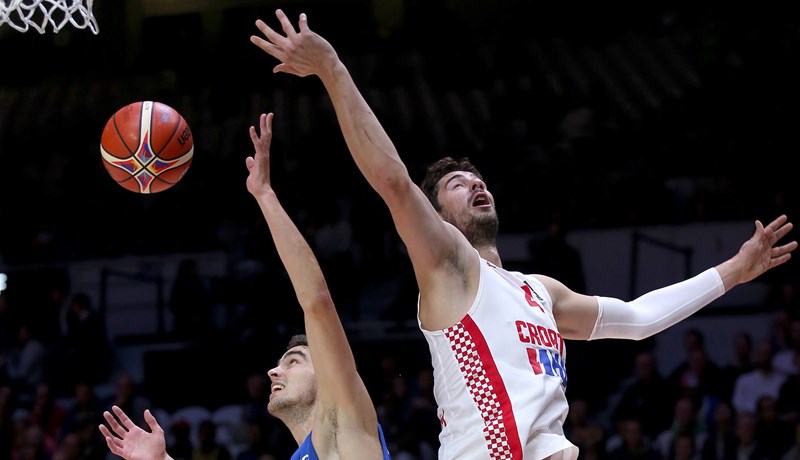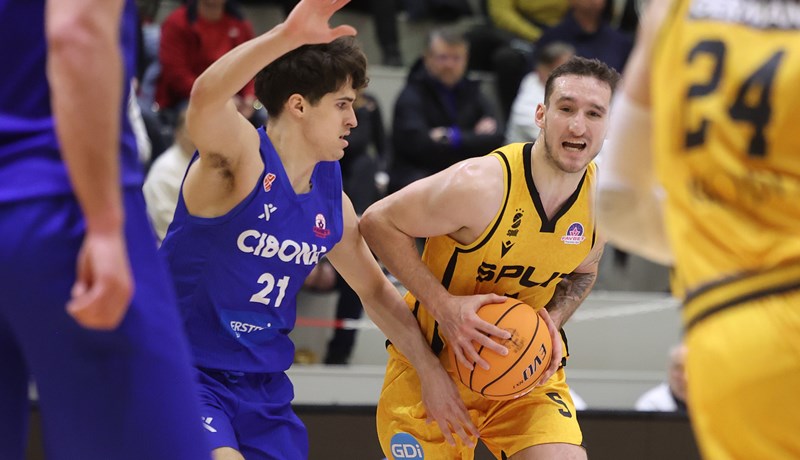NBA 2009-10
gorc je napisao/la:
jbg...sad je u qurcu i ta situacija s 'igranjem u europi' kad je odbio grke a sad bi vjerojatno objeručke prihvatio tu ponudubemti sad više nemamo ni tog jednog igrača za pratit u nba-ju
iako bih volio kad bi ga makar trejdali u neki drugi nba klub gdje bi imao zajamčeno mjesto backup playa...al koji yebemu?
Vidi cijeli citat
Kad pogledaš rostere apsolutno svih NBA ekipa, jednostavno se ne vidi niti jedna ekipa u kojoj bi Ukić bio prva zamjena u slučaju trejda, nažalost...
OK, ipak sam našao par interesantnih ekipa, Miami Heat koji nemaju prave zamjene za Maria Chalmersa, te dvije ekipe koje će ovisiti o akvizicijama u FA (free agent) periodu - Charlotte Bobcatsi (ako ne vrate natrag Raymonda Feltona) i New York Knicksi (ako ne dovedu natrag Natea Robinsona).
[uredio Papa Bear - 16. srpnja 2009. u 23:07]
Papa Bear je napisao/la:
madmax17 je napisao/la:
Ja vidim barem tri-četiri, može u Clipperse recimo.
Vidi cijeli citat
Je, istina, ima ih par, ali problem je ko će ić trejdat nekog baš za Roka Ukića, teško da će se to desit, nažalost.
Vidi cijeli citat
puno bi više volio da ga makar i trejdaju i da ima i nekih 15tak min po tekmi nego recimo da se vrati u europu i bude standardan 
yebat ga...ipak je ovvo nba...al ima eto ekipa,nađe se pokoja
kad bi ga barem trejdali..al yebat ga kad su mariona već utrpali,parkera također a obavili su i ovo s jackom...

...ništa ja nisam vidio,ja sammmmm pio vodu...
Cibona gostuje u Zadru: 'Moramo biti spremni odgovoriti na čvrstu igru u reketu'
Tomić prvo ime Joventuta u porazu u gostima kod Barcelone
Predbožićni derbi u SuperSport Premijer ligi, Zadar dočekuje Cibonu u dvorani Krešimira Ćosića
Split ubacio 122 poena i uvjerljivo slavio u gostima kod Samobora, 40 poena i 11 trica Jordana
Taj trade je dogovoren 1.7. ne znam zašto su čekali do sada s potvrdom...
a što se tiče Griffina evo jedan članak o Clippersima
All that stuff happened in the past. That's exactly what it is: It's in the past. No one can do anything about it now. If I am with the Clippers, it's going to be all about the future. No disrespect to anybody, but I could care less what happened 20 years ago, 15 years ago."
-- Blake Griffin
Dear Blake,
Run. Just start running. Run for your life. Run like the star of a horror movie. Don't turn around. Run and keep running.
I think you should play in Greece. Or Italy. Or Spain. Or anywhere else. You should play anywhere but for the Clippers. Your agents and advisors are in denial. They don't want you to seem like an ungrateful jerk. They want you to be as marketable and likable as possible. They have talked themselves into the following scenario: "If Blake can turn the Clippers around and become a star in the No. 2 TV market in the country, only good things will happen to him."
See, this is where they are wrong. The odds are overwhelming that bad things will happen to you until you leave. And you will. The Clippers are cursed. They have been cursed for 33 consecutive years. It's a real curse, not a "Curse of the Bambino"-type hex manufactured to sell books. There has to be a legitimate reason why the Clippers franchise has been falling apart like Jon and Kate for three-plus decades, right? We've seen too much losing, too much incompetence, too much bad luck, too many freak occurrences. There has to be an answer.
I studied the Clippers' mess for three days, put everything on paper and tried to figure out a common thread. Blaming Moses Malone was too easy. Why would Moses curse the Clippers? The man could barely speak. Blaming Bill Walton ignored three seasons of misfortune that came before him. Blake, this went deeper than one person. This was karmic. This was creepy. This was like … they'd been hexed. Like they had built an arena on a sacred burial ground or something.
And that's when I realized what happened. In a way, they did mess with a sacred burial ground. They messed with the Indians. And you don't mess with the Indians. Ever.
Allow me to explain.
When the NBA awarded Buffalo an expansion franchise starting in the 1970-71 season, the team named itself the "Braves" to recognize Buffalo's Native American history. That's when the trouble began, Blake. For Native Americans, there was no more important animal than the buffalo. They depended on it for survival. They wore its fur as clothes. They revered the "white buffalo" -- a rare type of buffalo, almost as though it was albino -- and considered it to be sacred. By linking the word "Buffalo" with "Braves," a commonly known term to describe Native American warriors, the team's owners were basically announcing, "We are embracing the Indians and representing them in an honorable way."
For God's sake, look at their first logo. It's an Indian headdress on top of a basketball face; instead of facial features, we see a blue buffalo. In their second season, they changed the logo to a fancy "B" with a feather sticking out of it. The message remained clear: We are embracing the Native Americans.
Starting to get worried, Blake? You should be. Everything went swimmingly for the first six seasons in Buffalo. Led by North Carolina star Bob McAdoo (who won three scoring titles and an MVP award), the Braves put themselves on the map with playoff battles against two future champs (the Celtics in '74 and '76) and a really good Bullets team in '75. Everything turned in the summer of 1976, the same summer we celebrated our country's 200th Independence Day. (Yes, a country we stole from the Native Americans. I'm going to say this was a bad omen.) Twenty days before the Bicentennial, on June 14, Buffalo owner Paul Snyder announced he was selling the Braves to a group that planned to move them to Hollywood, Fla.
Only one problem: Nobody wanted the Braves to move. The other NBA owners hated the thought of accruing extra travel costs flying down to Florida just because Snyder sold out. The town of Buffalo was furious and immediately blocked the move with a restraining order and a $10 million lawsuit. And since the league was merging with the ABA that same month, this was an additional headache the league didn't need.
The sale fell through. But not before two things happened. First, McAdoo turned off the locals by saying about a potential Florida move, "It doesn't make any difference to me, as long as I can play and get paid for it." Thanks for the support, Mac! Second, there was a karmic shift against the franchise; from that moment forward, everything started to go wrong. And why?
Because Paul Snyder messed with the Indians!!!
How many times have we seen a horror movie or a Western in which someone desecrated sacred Indian territory in some way? Does it ever turn out well for them? Ever? Hell, even the Amityville Horror house was built over a sacred burial ground. That's why I believe in this curse over the other media-manufactured ones: In this case, we have ample evidence that, no, it's not a great idea to mess with Native Americans from a karmic standpoint. And Paul Snyder did.
Once the Florida sale fell through, Snyder sold half his share to a buffoon named John Y. Brown, with Brown assuming full control during the 1976-77 season and swapping franchises with Celtics owner Irv Levin after the 1977-78 season. What did Levin do? He moved the Braves to San Diego and renamed them the Clippers. He might as well have just beheaded a white buffalo. But we're getting ahead of ourselves. Here's a timeline of everything that has happened to the Braves/Clippers franchise since June 14, 1976.
Pay attention, Blake. Pay close attention.
a što se tiče Griffina evo jedan članak o Clippersima
All that stuff happened in the past. That's exactly what it is: It's in the past. No one can do anything about it now. If I am with the Clippers, it's going to be all about the future. No disrespect to anybody, but I could care less what happened 20 years ago, 15 years ago."
-- Blake Griffin
Dear Blake,
Run. Just start running. Run for your life. Run like the star of a horror movie. Don't turn around. Run and keep running.
I think you should play in Greece. Or Italy. Or Spain. Or anywhere else. You should play anywhere but for the Clippers. Your agents and advisors are in denial. They don't want you to seem like an ungrateful jerk. They want you to be as marketable and likable as possible. They have talked themselves into the following scenario: "If Blake can turn the Clippers around and become a star in the No. 2 TV market in the country, only good things will happen to him."
See, this is where they are wrong. The odds are overwhelming that bad things will happen to you until you leave. And you will. The Clippers are cursed. They have been cursed for 33 consecutive years. It's a real curse, not a "Curse of the Bambino"-type hex manufactured to sell books. There has to be a legitimate reason why the Clippers franchise has been falling apart like Jon and Kate for three-plus decades, right? We've seen too much losing, too much incompetence, too much bad luck, too many freak occurrences. There has to be an answer.
I studied the Clippers' mess for three days, put everything on paper and tried to figure out a common thread. Blaming Moses Malone was too easy. Why would Moses curse the Clippers? The man could barely speak. Blaming Bill Walton ignored three seasons of misfortune that came before him. Blake, this went deeper than one person. This was karmic. This was creepy. This was like … they'd been hexed. Like they had built an arena on a sacred burial ground or something.
And that's when I realized what happened. In a way, they did mess with a sacred burial ground. They messed with the Indians. And you don't mess with the Indians. Ever.
Allow me to explain.
When the NBA awarded Buffalo an expansion franchise starting in the 1970-71 season, the team named itself the "Braves" to recognize Buffalo's Native American history. That's when the trouble began, Blake. For Native Americans, there was no more important animal than the buffalo. They depended on it for survival. They wore its fur as clothes. They revered the "white buffalo" -- a rare type of buffalo, almost as though it was albino -- and considered it to be sacred. By linking the word "Buffalo" with "Braves," a commonly known term to describe Native American warriors, the team's owners were basically announcing, "We are embracing the Indians and representing them in an honorable way."
For God's sake, look at their first logo. It's an Indian headdress on top of a basketball face; instead of facial features, we see a blue buffalo. In their second season, they changed the logo to a fancy "B" with a feather sticking out of it. The message remained clear: We are embracing the Native Americans.
Starting to get worried, Blake? You should be. Everything went swimmingly for the first six seasons in Buffalo. Led by North Carolina star Bob McAdoo (who won three scoring titles and an MVP award), the Braves put themselves on the map with playoff battles against two future champs (the Celtics in '74 and '76) and a really good Bullets team in '75. Everything turned in the summer of 1976, the same summer we celebrated our country's 200th Independence Day. (Yes, a country we stole from the Native Americans. I'm going to say this was a bad omen.) Twenty days before the Bicentennial, on June 14, Buffalo owner Paul Snyder announced he was selling the Braves to a group that planned to move them to Hollywood, Fla.
Only one problem: Nobody wanted the Braves to move. The other NBA owners hated the thought of accruing extra travel costs flying down to Florida just because Snyder sold out. The town of Buffalo was furious and immediately blocked the move with a restraining order and a $10 million lawsuit. And since the league was merging with the ABA that same month, this was an additional headache the league didn't need.
The sale fell through. But not before two things happened. First, McAdoo turned off the locals by saying about a potential Florida move, "It doesn't make any difference to me, as long as I can play and get paid for it." Thanks for the support, Mac! Second, there was a karmic shift against the franchise; from that moment forward, everything started to go wrong. And why?
Because Paul Snyder messed with the Indians!!!
How many times have we seen a horror movie or a Western in which someone desecrated sacred Indian territory in some way? Does it ever turn out well for them? Ever? Hell, even the Amityville Horror house was built over a sacred burial ground. That's why I believe in this curse over the other media-manufactured ones: In this case, we have ample evidence that, no, it's not a great idea to mess with Native Americans from a karmic standpoint. And Paul Snyder did.
Once the Florida sale fell through, Snyder sold half his share to a buffoon named John Y. Brown, with Brown assuming full control during the 1976-77 season and swapping franchises with Celtics owner Irv Levin after the 1977-78 season. What did Levin do? He moved the Braves to San Diego and renamed them the Clippers. He might as well have just beheaded a white buffalo. But we're getting ahead of ourselves. Here's a timeline of everything that has happened to the Braves/Clippers franchise since June 14, 1976.
Pay attention, Blake. Pay close attention.
Summer of 1976: Snyder fires Dr. Jack Ramsay as coach and replaces him
with Tates Locke. Dr. Jack gets hired by Portland and wins the 1977
title. The Braves/Clippers won't have another decent coach for 15
years. Not a good start.
October 1976: The Braves miraculously acquire young Moses Malone from Portland for a 1978 first-round pick and the perplexing figure of $232,000. (Note: Portland didn't want to pay Malone's $300K salary and already had Bill Walton at center. What's amazing is the Blazers won the 1977 title even after giving away Moses.) Six days later, Buffalo ships Moses to Houston for No. 1 picks in '77 and '78. Why give up on Moses that soon? Locke decided he didn't like him, playing Moses six minutes total in two games because, hey, when you already have John Shumate and Tom McMillen at power forward, why see what you might have with the most ballyhooed high school recruit since Lew Alcindor? In a related story, Locke was fired 10 weeks later.
December 1976: They sell McAdoo to the Knicks for John Gianelli and cash considerations. (In the span of two months, they dealt the '74-75, '78-79, '81-82 and '82-83 MVPs for two first-rounders and cash. Not a good start, Blake.) One month later, they trade one of those No. 1s from Houston (1977: No. 18 overall) to Golden State for center George Johnson. You know, because they needed a center after trading two of the best big men of that generation.
April 1977: The Braves finish 26-56 that season, kicking off a 16-year playoff drought. Two months later, they trade the No. 3 pick in a loaded draft (Marques Johnson) for Swen Nater and the 13th pick (Tate Armstrong), which is funny because they make another terrible trade to reacquire Johnson seven years later. Only the Braves/Clippers can have the same guy haunt them twice.
September 1977: Fresh off Adrian Dantley winning Rookie of the Year with them, the Braves celebrate by trading him to Indiana for overrated scorer Billy Knight. They follow that beauty by dealing Johnson, a 1978 No. 1 (eventually No. 4 overall: Micheal Ray Richardson) and a 1979 No. 1 (eventually No. 11 overall: Cliff Robinson) for All-Star Tiny Archibald. One month later, Tiny rips his Achilles tendon and misses the whole season. This is getting weird. You have to admit.
November 1977: Buffalo trades John Shumate and a 1979 No. 1 (turns out to be No. 10 overall: Roy Hamilton) for the immortal Marvin "Bad News" Barnes. If you're scoring at home, they just turned McAdoo, Malone, Dantley, the No. 3 pick in '77 and two other No. 1 picks into Nater, Knight, Archibald, Armstrong and a guy nicknamed "Bad News."
August 1978: Levin switches franchises with Brown, moves his team to San Diego and renames it the Clippers. So much for the Buffalo Braves. As part of the deal, Archibald, Barnes, Knight and two second-round picks (one ended up being Danny Ainge) go to Boston; Kevin Kunnert, Sidney Wicks, Kermit Washington and the rights to Boston's No. 8 pick in '78 (Freeman Williams) … and not Boston's No. 6 pick (Larry Bird). You don't catch those 50/50 breaks after you launch a basketball team in Buffalo, name it after brave Native American warriors and ditch everyone within eight years. You just don't.
October 1978: San Diego acquires World B. Free from Philly for a first-round pick in 1984 … a pick that ends up being No. 5 overall … a pick that ends up being Charles Barkley.
April 1979: Led by Free (28.8 ppg), Randy Smith (20.8 ppg) and Washington (9.8 RPG), the Clips finish with a 43-39 record and narrowly miss the playoffs. It's the last time they top 36 wins for 13 harrowing seasons. A fitting number.
August 1979: Levin signs free-agent center Bill Walton to a lavish six-year deal, giving up Kunnert, Washington and his 1980 No. 1 pick (eventually No. 7 overall: Mike Gminski) as compensation. Was Levin worried Walton had missed 203 games over his first five seasons because of repeated stress fractures in his feet? Of course not! Walton ends up playing 14 games over the next three seasons and just 169 games in six seasons as a Clipper. That could be you, Blake. Sign with Italy for a year. I'm telling you.
September 1979: They trade a 1986 No. 1 pick to Philly for Joe "Jellybean" Bryant (Kobe's dad), which would be like the Clips trading their unprotected 2016 No. 1 to Minnesota for Ryan Gomes. (Crap, I hope I didn't just give them an idea.) Oh, and that 1986 pick? It ended up being first overall. This is your new team, Blake.
June 1980: With their first No. 1 pick in four years, the Clips draft Michael Brooks ninth overall, two spots ahead of Kiki Vandeweghe … and Brooks does OK for three-plus seasons before blowing out his knee (and never plays for the Clips again). Two months later, they deal Free (fresh off a 30-ppg season) to Golden State for a washed-up Phil Smith and a 1984 No. 1 pick (eventually No. 8: Lancaster Gordon). So basically, for two years of Free, they moved backward in the '84 draft and missed out on Barkley. Well done.
Summer 1981: Donald Sterling buys the Clippers from Levin for $12.5 million, embarks on a quest to turn them into the worst franchise ever … and succeeds. You'll see him at home games, Blake. He's the old guy who sits midcourt, dresses like a nightclub singer, surrounds himself with cougars, loves Koreans and enters the locker room once a year to scream at everyone. Keep your distance.
June 1982: One year after snaring Tom Chambers with the No. 8 pick, the Clips pass on Dominique Wilkins and draft Terry Cummings No. 2 overall (tough to argue with the logic at the time, since Cummings won Rookie of the Year), giving them a nice set of young forwards who appear in six combined All-Star Games and 228 combined playoff games … of course, none with the Clippers. They're both gone by the summer of '84.
June 1983: The Clips deal Nater and the No. 4 pick (Byron Scott) to the Lakers for former All-Star guard Norm Nixon, who gives them three solid seasons before blowing out his knee during a summer softball game in New York's Central Park. Then he ruptures his Achilles tendon 13 months later and misses a second season. Then he loses both legs in a tragic roller disco accident in 1987. I made only one of those three things up.
Summer 1983: Cummings is diagnosed with a potentially deadly condition called heart arrhythmia. He can keep playing but has to start taking a super-strong heart medication called Cordarone. At this point, God is running out of ways to torture the Clippers and settles on just blowing out random ACLs for the next few years.
August 1983: San Diego trades Chambers to Seattle for James Donaldson and a 1984 first-rounder (eventually No. 14 overall: Michael Cage). Chambers plays another 14 seasons, makes two second-team All-NBA squads, plays in four All-Star Games, wins the MVP of the greatest All-Star Game ever (1987), scores 20,000 points and serves as the go-to-guy on three conference finalists. Cage? He goes down as having the NBA's best Jheri curls of the '80s. So, um … I think they lost that trade. Unless you love Jheri curls.
Spring 1984: The Clips finish another losing season and flee for Los Angeles, opting to play at the L.A. Sports Arena so Sterling can pretend he's a Hollywood heavy hitter. Thanks for the memories, San Diego: Six years, no playoff games. If only they had the foresight in 1978 to become the "San Diego Zoo."
June 1984: Blessed with the Nos. 8 and 14 picks in the greatest draft in NBA history, the Clips whiff on No. 8 (Gordon, taken just ahead of Kevin Willis and Otis Thorpe) and pick Michael Cage at No. 14 (two picks ahead of John Stockton). Would you rather have Gordon and Cage or Willis and Stockton? I thought so. Blake, please tell me your sneakers are on. As soon as you hit the last line of the column, start running.
August 1984: They trade Cummings, Ricky Pierce (a scoring stud off the bench) and Craig Hodges to Milwaukee for Marques Johnson, Junior Bridgeman, Harvey Catchings and cash. Why? Because they thought Johnson, a former UCLA star, might help them sell tickets. Or something. Is it ever a good idea to "upgrade" from a 23-year-old forward averaging a 23-10 to a 28-year-old forward averaging a 20-6? Of course not. Unless you're the Clippers.
April 1985: A rare feel-good Clips story: Waiver-wire pickup Derek Smith blossoms as a scorer (22 ppg, 54 percent FG) and legitimate building block. Hold this thought.
May 1985: In the first-ever NBA lottery, the Knicks snare the No. 1 pick (Patrick Ewing) and the Clippers finish third, settling on Benoit Benjamin (described at the time as another Joe Barry Carroll, one of those "Is that a compliment or an insult?" comparisons) over Xavier McDaniel (No. 4), Chris Mullin (No. 7) and Detlef Schrempf (No. 8). Benjamin goes on to utter one of the most famous NBA quotes ever uttered when he consoled a sobbing teammate after a Clippers loss by telling him, "Hey, you've gotta learn to be more casual." Needless to say, he's gone within five years.
Summer 1985: The Clips send Walton to Boston for Cedric Maxwell and a No. 1 pick in 1986. Walton is named Sixth Man of the Year and improbably plays 96 of 100 games for one of the greatest teams ever. He plays 60 percent as many games for the '86 Celtics as he did for the Clippers in six full seasons. You can't make this stuff up.
November 1985: Eleven games into the '85-86 season, Smith blows out his knee in about 370 different places. He's never the same. The following summer, they deal him to Sacramento (with Bridgeman and Franklin Edwards) for Larry Drew, Mike Woodson and a No. 1 pick in 1988. That means from January 1977 to August 1986, the Clippers traded EIGHT different players either during or after a season they averaged 18-plus points per game: McAdoo, Dantley, Knight, Smith, Free, Chambers, Cummings and Smith.
January 1986: The Clips acquire Darnell Valentine for Boston's No. 1 pick in 1986 (eventually, No. 24: Arvydas Sabonis), a mistake since Mark Price went 25th, Dennis Rodman 27th, Nate McMillan 30th and Kevin Duckworth 33rd. And don't forget, they would have had the No. 1 pick had they not traded it for a backup forward nicknamed Jellybean.
November 1986: While chasing a loose ball against Indiana, Marques Johnson accidentally rams head-first into Benjamin's midsection and ruptures a disk in his neck. He never plays again. In less than a year, the Clips suffered career-ending or -altering injuries to their three best players -- Smith, Nixon and Johnson -- and if that wasn't enough, Elgin Baylor took over as the team's GM in April and another team owned the Clips' No. 1 overall pick in June. That was the NBA equivalent of a bad bender. Like the kind Nic Cage went on in "Leaving Las Vegas."
(Note: How do you regroup after that? You sign a guy who was pleaded guilty to assaulting a female!!!! In this case, Quintin Dailey, who was such a bad guy that he once missed a game and appeared in the box score like this: "DNP: Evil." OK, I made that up.)
June 1987: The good news: Elgin acquires two extra first-rounders thanks to savvy trading (sending away Cedric Maxwell and Kurt Nimphius). The bad news: Elgin makes the picks. He takes Reggie Williams No. 4 … one spot ahead of Scottie Pippen (and ahead of Kevin Johnson, Horace Grant and Reggie Miller). He takes Joe Wolf at No. 13 and Kenny Norman at No. 19, missing Mark Jackson (18) and Reggie Lewis (22). In a draft laden with All-Stars, Elgin emerges with three guys who make a combined zero All-Star appearances. Elgin Baylor everybody!
January 1988: The Clips sign Michael Phelps to a 10-day contract. Only the Clips could sign the other Michael Phelps.
June 1988: After finally winning a lottery, the Clips happily take college star/sure thing Danny Manning with the first pick. The curse is over!!!!!! Then they trade Michael Cage and the No. 6 pick (Hersey Hawkins) for the No. 3 pick (Pittsburgh forward Charles Smith) and the rights to Gary Grant. If you're scoring at home, the Braves/Clippers have now taken seven forwards in the top nine picks since 1976: Dantley (6), Brooks (9), Chambers (8), Cummings (2), Williams (4), Manning (1) and Smith (3).
December 1988: Twenty-six games into his rookie season, Manning blows out an ACL. He's never the same. I'm telling you, Blake: Finish this column, then run. Just head north. Don't stop until you hit the Canadian border.
April 1989: The Clips finish their 10th straight losing season of the decade. The wins by season: 35, 36, 17, 25, 30, 31, 32, 12, 17, 21.
June 1989: The Clippers take Duke star Danny Ferry with the No. 2 overall pick. It's stupid for four reasons. First, he's Danny Ferry. Second, the last thing they needed was another forward. Third, they passed up Michigan's Glen Rice, who looked fantastic in the NCAA tournament and would have given them some much-needed outside shooting. And fourth, Ferry was already on record as saying to them, "Please, for the love of God, don't take me." In fact, if you ever watch the '89 draft on NBA-TV, look out for the Danny Ferry "I'm so screwed. I hope my dad can get me out of this" face after he gets picked. He looks like a passenger on Tom Hanks' FedEx plane in "Cast Away." One of those rare sports moments when you know right away, "This won't end well."
October 1989: With Ferry threatening to play in Italy, the Clippers are forced to deal him and Williams to Cleveland for Ron Harper and No. 1 picks in 1990 and 1992. Hey, anytime you can turn the No. 2 and No. 4 overall picks into Ron Harper and two non-lottery picks, you have to do it. Why didn't they take Glen Rice again?
December 1989: Averaging 23.0 points through 28 games with the Clips, Harper blows out his ACL. We're now up to five blown ACLs, two blown Achilles, one ruptured disc, one potentially deadly heart arrhythmia and multiple Walton foot fractures in a 12-year span since Paul Snyder ticked off the Native American spirits. I'm just saying.
June 1990: Picking eighth and 13th in one of the worst drafts ever, the Clips end up with -- you guessed it! -- two more forwards (Bo Kimble and Loy Vaught). I am convinced to this day that becoming a Clipper was the only thing that kept Kimble from winning multiple scoring titles. I swear. I really believe that. I'd take a lie detector and everything.
February 1991: Elgin turns Benjamin into Olden Polynice and two future late-first-rounders that amount to nothing. Four months later, he deals his first-rounder (No. 9: Stacey Augmon) and two second-rounders to Atlanta for a suddenly depressed Doc Rivers. Had he kept the pick, he could have just taken future All-Star Terrell Brandon. Then again …
October 1976: The Braves miraculously acquire young Moses Malone from Portland for a 1978 first-round pick and the perplexing figure of $232,000. (Note: Portland didn't want to pay Malone's $300K salary and already had Bill Walton at center. What's amazing is the Blazers won the 1977 title even after giving away Moses.) Six days later, Buffalo ships Moses to Houston for No. 1 picks in '77 and '78. Why give up on Moses that soon? Locke decided he didn't like him, playing Moses six minutes total in two games because, hey, when you already have John Shumate and Tom McMillen at power forward, why see what you might have with the most ballyhooed high school recruit since Lew Alcindor? In a related story, Locke was fired 10 weeks later.
December 1976: They sell McAdoo to the Knicks for John Gianelli and cash considerations. (In the span of two months, they dealt the '74-75, '78-79, '81-82 and '82-83 MVPs for two first-rounders and cash. Not a good start, Blake.) One month later, they trade one of those No. 1s from Houston (1977: No. 18 overall) to Golden State for center George Johnson. You know, because they needed a center after trading two of the best big men of that generation.
April 1977: The Braves finish 26-56 that season, kicking off a 16-year playoff drought. Two months later, they trade the No. 3 pick in a loaded draft (Marques Johnson) for Swen Nater and the 13th pick (Tate Armstrong), which is funny because they make another terrible trade to reacquire Johnson seven years later. Only the Braves/Clippers can have the same guy haunt them twice.
September 1977: Fresh off Adrian Dantley winning Rookie of the Year with them, the Braves celebrate by trading him to Indiana for overrated scorer Billy Knight. They follow that beauty by dealing Johnson, a 1978 No. 1 (eventually No. 4 overall: Micheal Ray Richardson) and a 1979 No. 1 (eventually No. 11 overall: Cliff Robinson) for All-Star Tiny Archibald. One month later, Tiny rips his Achilles tendon and misses the whole season. This is getting weird. You have to admit.
November 1977: Buffalo trades John Shumate and a 1979 No. 1 (turns out to be No. 10 overall: Roy Hamilton) for the immortal Marvin "Bad News" Barnes. If you're scoring at home, they just turned McAdoo, Malone, Dantley, the No. 3 pick in '77 and two other No. 1 picks into Nater, Knight, Archibald, Armstrong and a guy nicknamed "Bad News."
August 1978: Levin switches franchises with Brown, moves his team to San Diego and renames it the Clippers. So much for the Buffalo Braves. As part of the deal, Archibald, Barnes, Knight and two second-round picks (one ended up being Danny Ainge) go to Boston; Kevin Kunnert, Sidney Wicks, Kermit Washington and the rights to Boston's No. 8 pick in '78 (Freeman Williams) … and not Boston's No. 6 pick (Larry Bird). You don't catch those 50/50 breaks after you launch a basketball team in Buffalo, name it after brave Native American warriors and ditch everyone within eight years. You just don't.
October 1978: San Diego acquires World B. Free from Philly for a first-round pick in 1984 … a pick that ends up being No. 5 overall … a pick that ends up being Charles Barkley.
April 1979: Led by Free (28.8 ppg), Randy Smith (20.8 ppg) and Washington (9.8 RPG), the Clips finish with a 43-39 record and narrowly miss the playoffs. It's the last time they top 36 wins for 13 harrowing seasons. A fitting number.
August 1979: Levin signs free-agent center Bill Walton to a lavish six-year deal, giving up Kunnert, Washington and his 1980 No. 1 pick (eventually No. 7 overall: Mike Gminski) as compensation. Was Levin worried Walton had missed 203 games over his first five seasons because of repeated stress fractures in his feet? Of course not! Walton ends up playing 14 games over the next three seasons and just 169 games in six seasons as a Clipper. That could be you, Blake. Sign with Italy for a year. I'm telling you.
September 1979: They trade a 1986 No. 1 pick to Philly for Joe "Jellybean" Bryant (Kobe's dad), which would be like the Clips trading their unprotected 2016 No. 1 to Minnesota for Ryan Gomes. (Crap, I hope I didn't just give them an idea.) Oh, and that 1986 pick? It ended up being first overall. This is your new team, Blake.
June 1980: With their first No. 1 pick in four years, the Clips draft Michael Brooks ninth overall, two spots ahead of Kiki Vandeweghe … and Brooks does OK for three-plus seasons before blowing out his knee (and never plays for the Clips again). Two months later, they deal Free (fresh off a 30-ppg season) to Golden State for a washed-up Phil Smith and a 1984 No. 1 pick (eventually No. 8: Lancaster Gordon). So basically, for two years of Free, they moved backward in the '84 draft and missed out on Barkley. Well done.
Summer 1981: Donald Sterling buys the Clippers from Levin for $12.5 million, embarks on a quest to turn them into the worst franchise ever … and succeeds. You'll see him at home games, Blake. He's the old guy who sits midcourt, dresses like a nightclub singer, surrounds himself with cougars, loves Koreans and enters the locker room once a year to scream at everyone. Keep your distance.
June 1982: One year after snaring Tom Chambers with the No. 8 pick, the Clips pass on Dominique Wilkins and draft Terry Cummings No. 2 overall (tough to argue with the logic at the time, since Cummings won Rookie of the Year), giving them a nice set of young forwards who appear in six combined All-Star Games and 228 combined playoff games … of course, none with the Clippers. They're both gone by the summer of '84.
June 1983: The Clips deal Nater and the No. 4 pick (Byron Scott) to the Lakers for former All-Star guard Norm Nixon, who gives them three solid seasons before blowing out his knee during a summer softball game in New York's Central Park. Then he ruptures his Achilles tendon 13 months later and misses a second season. Then he loses both legs in a tragic roller disco accident in 1987. I made only one of those three things up.
Summer 1983: Cummings is diagnosed with a potentially deadly condition called heart arrhythmia. He can keep playing but has to start taking a super-strong heart medication called Cordarone. At this point, God is running out of ways to torture the Clippers and settles on just blowing out random ACLs for the next few years.
August 1983: San Diego trades Chambers to Seattle for James Donaldson and a 1984 first-rounder (eventually No. 14 overall: Michael Cage). Chambers plays another 14 seasons, makes two second-team All-NBA squads, plays in four All-Star Games, wins the MVP of the greatest All-Star Game ever (1987), scores 20,000 points and serves as the go-to-guy on three conference finalists. Cage? He goes down as having the NBA's best Jheri curls of the '80s. So, um … I think they lost that trade. Unless you love Jheri curls.
Spring 1984: The Clips finish another losing season and flee for Los Angeles, opting to play at the L.A. Sports Arena so Sterling can pretend he's a Hollywood heavy hitter. Thanks for the memories, San Diego: Six years, no playoff games. If only they had the foresight in 1978 to become the "San Diego Zoo."
June 1984: Blessed with the Nos. 8 and 14 picks in the greatest draft in NBA history, the Clips whiff on No. 8 (Gordon, taken just ahead of Kevin Willis and Otis Thorpe) and pick Michael Cage at No. 14 (two picks ahead of John Stockton). Would you rather have Gordon and Cage or Willis and Stockton? I thought so. Blake, please tell me your sneakers are on. As soon as you hit the last line of the column, start running.
August 1984: They trade Cummings, Ricky Pierce (a scoring stud off the bench) and Craig Hodges to Milwaukee for Marques Johnson, Junior Bridgeman, Harvey Catchings and cash. Why? Because they thought Johnson, a former UCLA star, might help them sell tickets. Or something. Is it ever a good idea to "upgrade" from a 23-year-old forward averaging a 23-10 to a 28-year-old forward averaging a 20-6? Of course not. Unless you're the Clippers.
April 1985: A rare feel-good Clips story: Waiver-wire pickup Derek Smith blossoms as a scorer (22 ppg, 54 percent FG) and legitimate building block. Hold this thought.
May 1985: In the first-ever NBA lottery, the Knicks snare the No. 1 pick (Patrick Ewing) and the Clippers finish third, settling on Benoit Benjamin (described at the time as another Joe Barry Carroll, one of those "Is that a compliment or an insult?" comparisons) over Xavier McDaniel (No. 4), Chris Mullin (No. 7) and Detlef Schrempf (No. 8). Benjamin goes on to utter one of the most famous NBA quotes ever uttered when he consoled a sobbing teammate after a Clippers loss by telling him, "Hey, you've gotta learn to be more casual." Needless to say, he's gone within five years.
Summer 1985: The Clips send Walton to Boston for Cedric Maxwell and a No. 1 pick in 1986. Walton is named Sixth Man of the Year and improbably plays 96 of 100 games for one of the greatest teams ever. He plays 60 percent as many games for the '86 Celtics as he did for the Clippers in six full seasons. You can't make this stuff up.
November 1985: Eleven games into the '85-86 season, Smith blows out his knee in about 370 different places. He's never the same. The following summer, they deal him to Sacramento (with Bridgeman and Franklin Edwards) for Larry Drew, Mike Woodson and a No. 1 pick in 1988. That means from January 1977 to August 1986, the Clippers traded EIGHT different players either during or after a season they averaged 18-plus points per game: McAdoo, Dantley, Knight, Smith, Free, Chambers, Cummings and Smith.
January 1986: The Clips acquire Darnell Valentine for Boston's No. 1 pick in 1986 (eventually, No. 24: Arvydas Sabonis), a mistake since Mark Price went 25th, Dennis Rodman 27th, Nate McMillan 30th and Kevin Duckworth 33rd. And don't forget, they would have had the No. 1 pick had they not traded it for a backup forward nicknamed Jellybean.
November 1986: While chasing a loose ball against Indiana, Marques Johnson accidentally rams head-first into Benjamin's midsection and ruptures a disk in his neck. He never plays again. In less than a year, the Clips suffered career-ending or -altering injuries to their three best players -- Smith, Nixon and Johnson -- and if that wasn't enough, Elgin Baylor took over as the team's GM in April and another team owned the Clips' No. 1 overall pick in June. That was the NBA equivalent of a bad bender. Like the kind Nic Cage went on in "Leaving Las Vegas."
(Note: How do you regroup after that? You sign a guy who was pleaded guilty to assaulting a female!!!! In this case, Quintin Dailey, who was such a bad guy that he once missed a game and appeared in the box score like this: "DNP: Evil." OK, I made that up.)
June 1987: The good news: Elgin acquires two extra first-rounders thanks to savvy trading (sending away Cedric Maxwell and Kurt Nimphius). The bad news: Elgin makes the picks. He takes Reggie Williams No. 4 … one spot ahead of Scottie Pippen (and ahead of Kevin Johnson, Horace Grant and Reggie Miller). He takes Joe Wolf at No. 13 and Kenny Norman at No. 19, missing Mark Jackson (18) and Reggie Lewis (22). In a draft laden with All-Stars, Elgin emerges with three guys who make a combined zero All-Star appearances. Elgin Baylor everybody!
January 1988: The Clips sign Michael Phelps to a 10-day contract. Only the Clips could sign the other Michael Phelps.
June 1988: After finally winning a lottery, the Clips happily take college star/sure thing Danny Manning with the first pick. The curse is over!!!!!! Then they trade Michael Cage and the No. 6 pick (Hersey Hawkins) for the No. 3 pick (Pittsburgh forward Charles Smith) and the rights to Gary Grant. If you're scoring at home, the Braves/Clippers have now taken seven forwards in the top nine picks since 1976: Dantley (6), Brooks (9), Chambers (8), Cummings (2), Williams (4), Manning (1) and Smith (3).
December 1988: Twenty-six games into his rookie season, Manning blows out an ACL. He's never the same. I'm telling you, Blake: Finish this column, then run. Just head north. Don't stop until you hit the Canadian border.
April 1989: The Clips finish their 10th straight losing season of the decade. The wins by season: 35, 36, 17, 25, 30, 31, 32, 12, 17, 21.
June 1989: The Clippers take Duke star Danny Ferry with the No. 2 overall pick. It's stupid for four reasons. First, he's Danny Ferry. Second, the last thing they needed was another forward. Third, they passed up Michigan's Glen Rice, who looked fantastic in the NCAA tournament and would have given them some much-needed outside shooting. And fourth, Ferry was already on record as saying to them, "Please, for the love of God, don't take me." In fact, if you ever watch the '89 draft on NBA-TV, look out for the Danny Ferry "I'm so screwed. I hope my dad can get me out of this" face after he gets picked. He looks like a passenger on Tom Hanks' FedEx plane in "Cast Away." One of those rare sports moments when you know right away, "This won't end well."
October 1989: With Ferry threatening to play in Italy, the Clippers are forced to deal him and Williams to Cleveland for Ron Harper and No. 1 picks in 1990 and 1992. Hey, anytime you can turn the No. 2 and No. 4 overall picks into Ron Harper and two non-lottery picks, you have to do it. Why didn't they take Glen Rice again?
December 1989: Averaging 23.0 points through 28 games with the Clips, Harper blows out his ACL. We're now up to five blown ACLs, two blown Achilles, one ruptured disc, one potentially deadly heart arrhythmia and multiple Walton foot fractures in a 12-year span since Paul Snyder ticked off the Native American spirits. I'm just saying.
June 1990: Picking eighth and 13th in one of the worst drafts ever, the Clips end up with -- you guessed it! -- two more forwards (Bo Kimble and Loy Vaught). I am convinced to this day that becoming a Clipper was the only thing that kept Kimble from winning multiple scoring titles. I swear. I really believe that. I'd take a lie detector and everything.
February 1991: Elgin turns Benjamin into Olden Polynice and two future late-first-rounders that amount to nothing. Four months later, he deals his first-rounder (No. 9: Stacey Augmon) and two second-rounders to Atlanta for a suddenly depressed Doc Rivers. Had he kept the pick, he could have just taken future All-Star Terrell Brandon. Then again …
- Najnovije
- Najčitanije
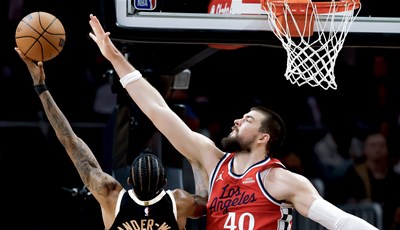

Predbožićni derbi u SuperSport Premijer ligi, Zadar dočekuje Cibonu u dvorani Krešimira Ćosića
6 sati•SuperSport Premijer liga
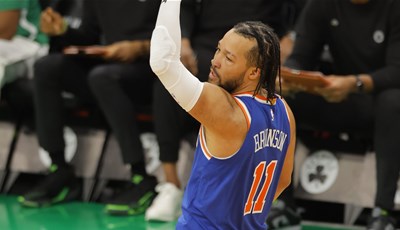
Šarić bez nastupa u pobjedi Kingsa, fenomenalni Brunson predvodio Knickse, Spursi bolji od Wizardsa
7 sati•NBA
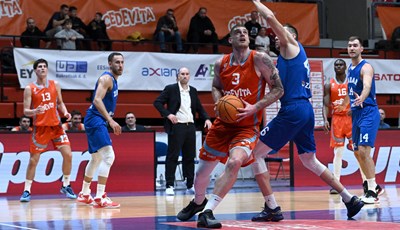
Cedevita Junior poražena i u Šibeniku, visoka pobjeda Dinama
14 sati•SuperSport Premijer liga
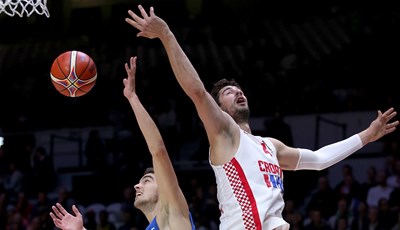
Tomić prvo ime Joventuta u porazu u gostima kod Barcelone
19 sati•Španjolska košarka
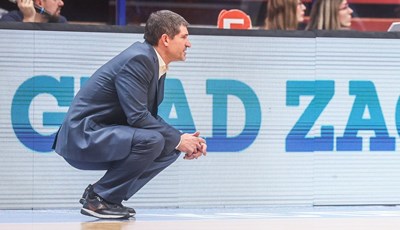
Cibona gostuje u Zadru: 'Moramo biti spremni odgovoriti na čvrstu igru u reketu'
21 sat•SuperSport Premijer liga
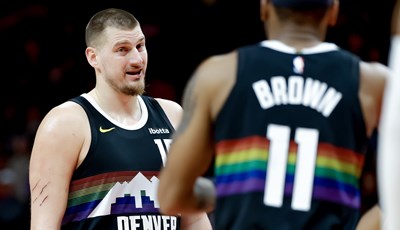
Durant vodio Rocketse do pobjede u Denveru, Matkoviću četvrta pobjeda u nizu s Pelicansima
1 dan•NBA

Ivica Zubac ozlijeđen, Clippersi ipak uspjeli prekinuti seriju poraza
1 dan•NBA
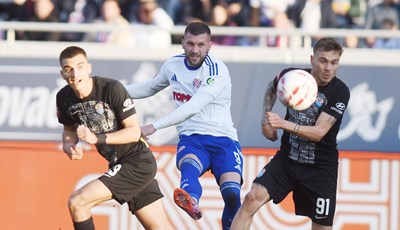
Bizarna utakmica na Poljudu, Hajduk s devetoricom sačuvao pobjedu protiv Vukovara!
22 sata•Nogomet
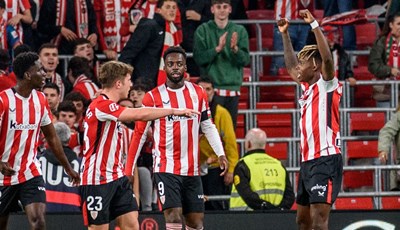
Athletic Bilbao uz dosta defenzivnih problema dočekuje neugodni Espanyol
4 sata•Nogomet
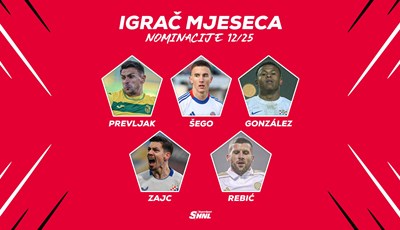
SuperSport HNL nominacije: Tražimo one najbolje za kraj 2025. godine!
4 sata•Nogomet
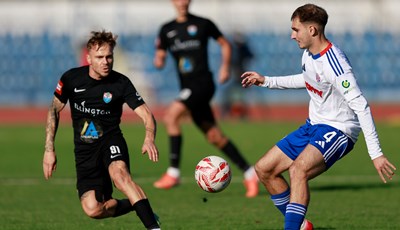
Kronologija: Hajduk izvukao pobjedu protiv Vukovara 1991!
1 dan•Nogomet
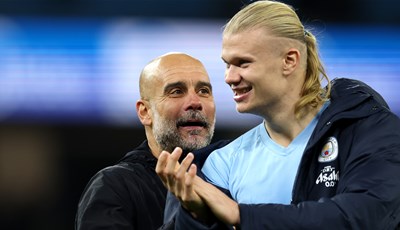
Guardiola: 'Kad se igrači vrate, provjerit ću jesu li dobili na težini'
59 min•Nogomet
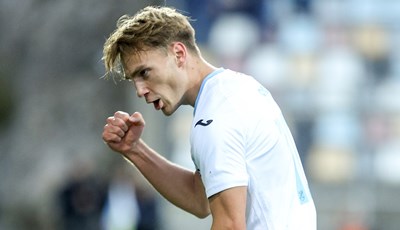
Toni Fruk igrač godine po izboru kapetana SuperSport HNL-a
2 sata•Nogomet
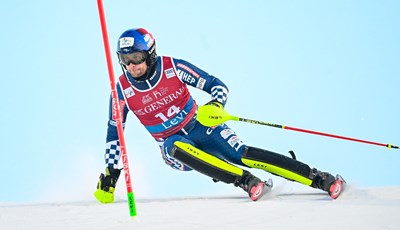
Kolega jako dobar nakon prve vožnje, Rodeš i Zubčić bez borbe za bodove
3 sata•Zimski sportovi
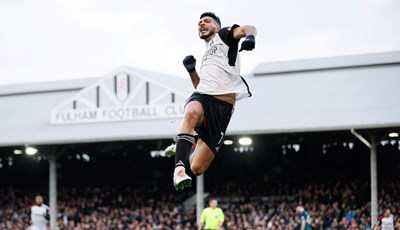
Fulham nakon bolnog ispadanja u EFL kupu dočekuje sve bolji Dycheov Forest
5 sati•Nogomet




